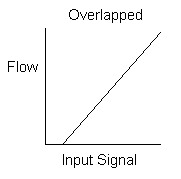
These hydraulic system problems can make system tuning difficult or impossible.
Nonlinear Valves
A valve is linear when the flow through it is directly proportional to the input signal over the entire range of the input signal:

It is nonlinear when the output is not directly proportional to the input. You may find two types of valve non-linearity:
Overlapped valves - Oil does not start to flow through these valves until the spool has moved some distance. This causes a dead band in the system, where small amounts of drive do not produce motion. Overlapped valves are designed for manual and on/off type control and are not suited for servo control. These valves should be replaced with non-overlapped valves.

Curvilinear valves - The flow through these valves increases slowly as the input signal increases for the first 20% of range. Beyond 20% the flow increases rapidly as the input increases. This is equivalent to having two different gains for different signal levels. The low gain at low flow causes poor response at slow speeds, and the high gain at high speed can cause instability. These problems are more pronounced when heavy loads are moved by relatively small cylinders.

Slow-Response Valves
Valves with slow response cause the RMC to overcompensate for disturbances in the motion of the system. Since the system does not respond immediately to the control signal, the RMC continues to increase the drive signal. By the time the system begins to respond to the error, the control signal has become too large and the system overshoots. The RMC then attempts to control in the opposite direction, but again it overshoots. These valves can cause the system to oscillate around the set point as the RMC overshoots first in one direction, then the other.
Hoses
Long hoses between the valves and cylinder act as accumulators and make the system respond as if it has a spring in it (imagine trying to control the position of one end of a Slinky™ by moving the other end!). The lines between the valves and cylinders must be as short and rigid as possible.
Pumps and Accumulators
Insufficient pump and/or accumulator capacity will cause the system response to degrade during a move because the effective pressure drops.
Pressure transients due to insufficient accumulator volume cause jerky motion, particularly during starts and stops.
Note: Even systems with ’r;fast’ pumps usually require at least a small accumulator near the cylinder to maintain the constant pressure needed to get smooth motion.
Insufficient pump capacity can result in inadequate control when moving many axes simultaneously or when making long moves. In these cases pressure can drop so much a fully open valve cannot maintain the requested speed.
Identification and Correction
To identify and correct these problems, make a move with very low (or zero) gains except the Feed Forward terms. Graph the move. The graph (ignoring the Position terms) should show:

If the actual speed and target speed show:

Your valve probably has overlap. Replace the valve with a linear one or try increasing the Dead Band Eliminator value.
If the speeds show:

Your valve is probably curvilinear. Replace the valve with a linear one or increase the proportional gain and tune the system for high-speed stability; expect poor control at low speed and when stopped.
If the speeds show:

You may have too much hose between the valve and the cylinder. Reduce the amount of hose or add differential gain (usually less than 5).
If the speeds show:

Your valve may have slow response. Change to a faster valve or add Acceleration Feed Forward.
With normal gain values, if the graph shows:

Your pump and/or accumulator may be inadequate (you are running out of oil). Reduce speed, increase pump pressure, add accumulator volume, or get a bigger pump.
Copyright (c) 1997-2015 by Delta Computer Systems, Inc.